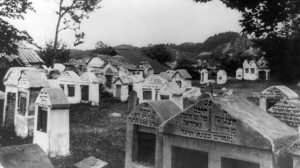
A photo of the historic Šnipiškės cemetery in 1922 before its destruction by the Soviet authorities 26 years later.
VILNIUS — After four years of back and forth between the world Jewish community and the Lithuanian government, an agreement signed today dictates the exact boundaries of the historic Šnipiškės cemetery, which became famous worldwide in 2005 after developers began constructing apartments on top of the former cemetery grounds.
The cemetery was closed by Imperial Russian authorities in 1831 before being destroyed by the Soviets in 1949, who then built a stadium and indoor sports arena on the site. However, Jews still consider the site to be sacred. It was the burial ground of the famous rabbi Elijah ben Shlomo Zalman, the Vilna Gaon. His grave was removed before the cemetery was destroyed.
Simonas Gurevičius, chairman of the Vilnius Jewish Community organization, told Baltic Reports that the local Jewry is very pleased with the outcome.
“The Jewish community had two aims – the graves were to be untouched so those people may rest in peace and number two was to let the city develop,” Gurevičius said. “We are very happy. This is due to the change in the new government – instead of empty promises, they came up to what they said. We admire it. We are happy now that it is being resolved and we want to make sure that everything that is on paper now gets put into action.”
City officials say the agreement stipulates that buildings already on the site do not need to be modified or demolished. Meanwhile Lithuanian president Dalia Grybauskaitė announced Monday that the restitution for formerly Jewish-owned property in Lithuania would be a priority of her administration.
Rabbi Andrew Baker, director of International Jewish Affairs at the American Jewish Committee, has visited Lithuania numerous times to lobby the government for the restitution of Jewish property in Lithuania. Baker told Baltic Reports that he is skeptical that this signals any real change in Jewish affairs in the country.
“I would hope this signals a change in dealing with other Jewish issues, but I am not too optimistic. At the moment the government seems intent on promoting inadequate legislation that would pay only a small sum for compensation of former Jewish communal property, despite hearing criticism from many of us,” Baker said. “When you keep in mind that this would provide the only real resources for Jewish communal life, including religious, educational, welfare and cultural needs, it is not a good sign.”
However, Baker said he is pleased that the cemetery boundaries have been officially defined.
“At long last this does signal a resolution to the problem, which will certainly be warmly received by Jewish organizations and individuals who were troubled that the desecration of graves had occurred and further desecration was still possible,” he said.

The Vilnius Concert and Sport Palace was built by the communists in 1971 in the middle of the former cemetery. Photo by Nathan Greenhalgh.
There had been fierce debate between the Jewish community, developer Kazimieras Musteikis and the Vilnius municipality. The latter two had insisted previously that the apartments did not infringe on the cemetery grounds and that the actual burial grounds may be elsewhere.
The international outcry of the world Jewish community led rabbis from across the world to Lithuania to petition the government and even led to an official condemnation from the U.S. House of Representatives in 2008.
Lithuania’s Ministry of Culture signed the document along with Heritage Foundation for Preservation of Jewish Cemeteries, the Lithuanian Jewish community and representatives of the Cultural Heritage Department.
Cultural Heritage Department Varnaitė Diana announced yesterday that the agreement on the boundaries had been signed and that the former cemetery site would be protected in future.












